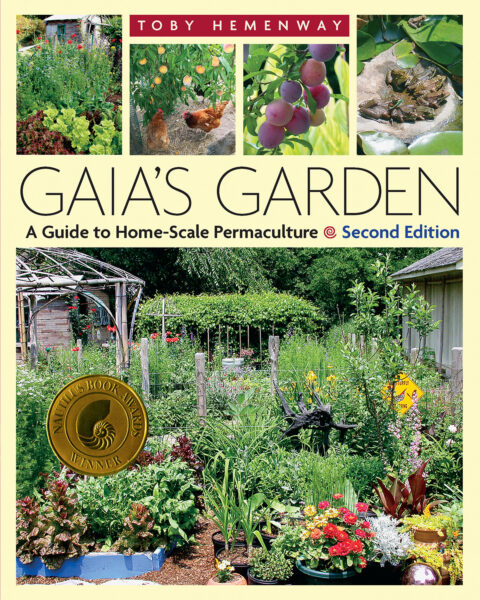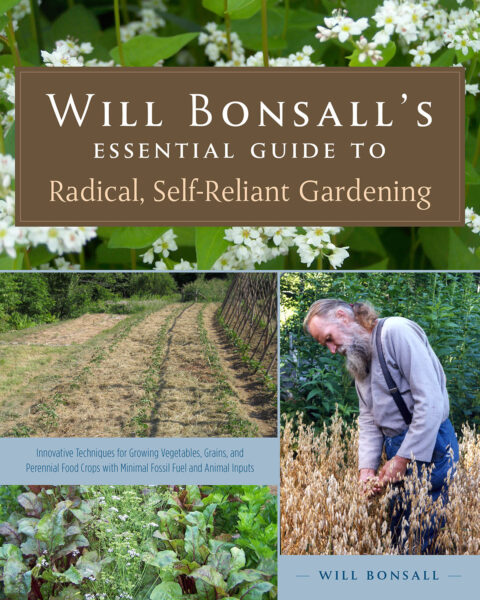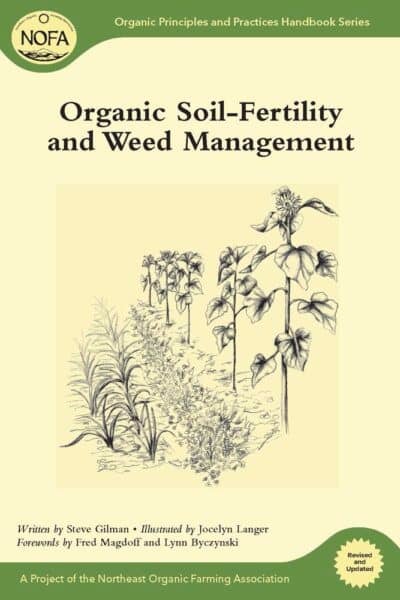All Purpose Potting Soil Recipe: The Perfect Mix
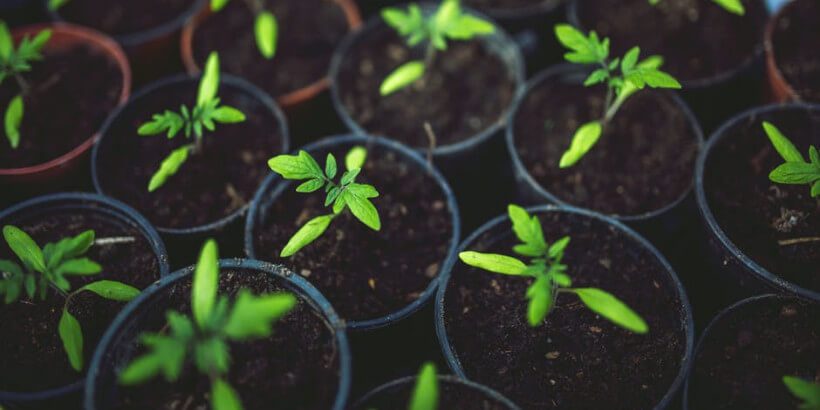
Check out this easy, all-purpose recipe for potting soil!
The above excerpt is from The Community-Scale Permaculture Farm by Josh Trought. It has been adapted for the web.
Annual plants require an early start to bear fruit in the short growing season of New England. The planting medium, daylight length, and temperature conditions are crucial factors for a healthy nursery of seedlings. In an attempt to localize our annual production we start seedlings on-site. This production requires specific timing and appropriate conditions for each species of annual.
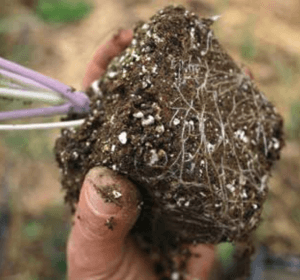
A kale transplant, ready for the ground, has been nurtured through the entire process of seeding in the basement, potting up, and hardening off in the Big Cold Frame. The fine root hairs have expanded throughout the soil.
Our indoor seedling nursery is a compromise between our attempts to provide a food system that is expansive and one that is acceptable for the conventional consumer’s palate. We grow many vegetables, such as eggplants and tomatoes, that are not native to this climate and require a longer season to bear fruit. We also invest in indoor operations to extend the growing season and maximize the production of our operations. This investment is substantial in terms of time, energy, and effort.
There are many choices regarding how to grow nursery starts. We have resorted to the standard plastic trays that are common in the nursery industry. The trays provide individual cells so seedlings can be easily transferred for transplanting without root damage. These containers provide a shape into which the soil and root fibers can mold and resist erosion from watering. As an alternative to plastic we have also made newspaper pots by rolling the paper into an origami-shape container. These pots are laborious to construct, though fully functional for seedling production. We also have used large quantities of recycled containers that were originally purposed for yogurt or soy milk. These containers can be functional, though they require substantial drainage holes to be drilled to allow aeration and bottom watering capacity, which encourages healthy plant growth. Round pots can also increase the complexity of the spatial relations in the nursery whereas square pots can stack together in higher volumes. We have also considered purchasing gadgetry to make soil blocks, which would eliminate our need for plastic trays and containers; however, we have resisted this course of action because peat moss or coconut fibers are typically used to retain moisture and the block’s structure in this system. We have been reluctant to add another layer of dependence in sourcing this ingredient material as a component in the process of food system. That said, we will continue to experiment in choosing alternatives incentivized by circumstance and ethical inquiry.
To build our soil medium we start by considering the needs of the plant roots. The medium must have the capacity to retain moisture while also being porous and well drained. The medium should have structure to allow the roots to grasp the material and prevent damage during the transplanting phase. This medium also provides a nutrient and energetic boost for the initial growth of the plant.
To create this medium we have developed an all-purpose potting soil recipe. The recipe we are currently using consists of 5 parts loam, 5 parts compost, 1.5 parts vermiculite, 1.5 parts perlite, one cup humates, and a quart of Paul Sachs’s Pro-Start 2-3-3. This mixture allows us to build up the existing soil medium by incorporating portions of the limited supplies of compost and imported soil amendments.
Loam is sourced on-site. The local loam is sandy and well drained, providing a basic building block for our soil fabrication. This material, however, lacks sufficient nutrients, structure, and water retention capacity to maximize the health of seedlings. Consequently, we mix in additional components to improve the medium.
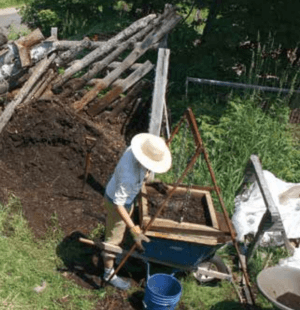
The compost sifter is a homemade tool. The A-frame can be moved to a finished compost pile, and with a wheelbarrow placed below the hanging frame, the sifted material can be wheeled easily to the Big Cold Frame or basement seeding stations.
The compost that we reserve for our potting soil is typically the highest quality that we can attain. It is important to source compost that is nutrient rich and free of weed seeds. The structure of superior compost provides particulate material that helps retain moisture and provide soil structure. We generally sift the compost through a quarter-inch screen so the large indigestible particles are eliminated from the mix that is to be returned to the compost heap.
Sifting compost can be laborious. We use framed screening to sift it through. To augment the process, screens can be suspended by a structure: As the compost swings in the screen, the motion encourages sifting. Other mechanized tumbler structures can provide this filtration process, producing a fine, soft, black, crumbly compost.
Vermiculite and perlite are soil amendments that we currently source from the agri-industrial complex. Vermiculite is organically certified and is created from heating the mineral mica to absurd temperatures. It is relatively inexpensive and compensates for high proportions of loam by providing superior moisture retention and lightening soils as a conditioner. Perlite comes from volcanic glass and reduces compaction by offering high permeability and low water retention.
We also incorporate various soil amendments in our potting soil medium. These amendments are intended to provide energetic components and nutrients that are readily available to plant roots as well as long-term nourishment for the soil food web. The amendments are generally rated by their proportions of nitrogen, phosphorous, and potassium (NPK). While the NPK proportions provide a measure of the amendments’ capacity, this over- simplification of the seedling’s necessities does no service to the reality that the plants require over fifty elemental nutrients for health.
Recommended Reads
Recent Articles
With the right strategies and practices, composting on a small farm is surprisingly easy and inexpensive. Just follow these steps for making compost, and your farm will be thriving in no time! The following excerpt is from The Lean Farm Guide to Growing Vegetables by Ben Hartman. It has been adapted for the web. (All photographs by Ben…
Read MoreGarlic mustard: while known as “invasive,” this plant can be consumed in its entirety and has great nutritional value. Plus, the garlic-flavor is a perfect addition to any recipe that calls for mustard! The following are excerpts from Beyond the War on Invasive Species by Tao Orion and The Wild Wisdom of Weeds by Katrina…
Read MoreEveryone loves a refreshing, fermented, nutritious drink…even your garden! Take your fermentation skills out of the kitchen and into the garden by brewing fermented plant juice. The following is an excerpt from The Regenerative Grower’s Guide to Garden Amendments by Nigel Palmer. It has been adapted for the web. How to Make Fermented Plant Juice Fermented…
Read MoreWant to see your crops thrive this upcoming growing season? The key is in soil fertility and health. Spend time maintaining your soil’s health to guarantee bigger and better crops come harvest time! The following is an excerpt from No-Till Intensive Vegetable Culture by Bryan O’Hara. It has been adapted for the web. What Is Soil Fertility?…
Read MoreMany know the effects of catnip on our feline friends, but few realize that catnip has medicinal effects for humans. From stomach aches to reducing fevers, catnip is a versatile herb with many benefits. The next time you grow this plant for your cat you may end up taking a few cuttings for yourself! The…
Read More

